Review and photos by BlueKrono, edited by DinoToyBlog
If I were asked to pick a favorite dinosaur toy it would be a challenging query, but I think the one I’d settle on would be the Marx Kronosaurus. A relic of Marx’s early dinosaur lines, the swan-necked prehistoric reptile has a history going back almost a century. I have spent years digging up its fascinating story, which involves the theft of a painting from a museum, a dynamite-slinging murderer, and an eccentric millionaire known as “The Toy King”.
Kronosaurus queenslandicus was a pliosaur like Liopleurodon, Pliosaurus and Rhomaleosaurus. The largest member of this group, it was the apex predator of the oceans 125-100 million years ago. Its skull was larger than any theropod dinosaur’s and its massive, conical teeth indicated a preference for large prey.
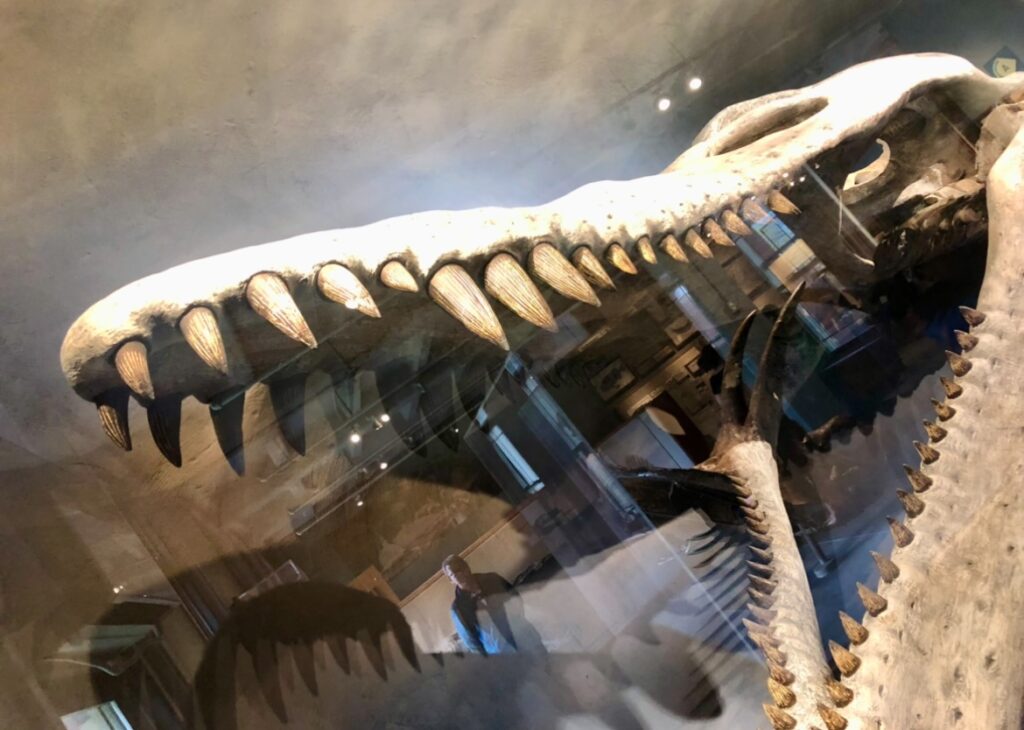
Its genus name is derived from the Greek Titan Cronus, a terrifying being who attacked and overthrew his own father to become King of the Gods. Fearing being overthrown by his own children in turn, the ravenous Cronus devoured them all. His son Zeus was hidden at birth by his mother and eventually overthrew the tyrant and banished him to Tarterus. Kronosaurus’s species name is a bit more grounded in reality, deriving from the state of Queensland in northern Australia where the first specimen was discovered in 1899 by Andrew Crombie. The species was officially described in 1924 by Albert Heber Longman of the Queensland Museum. With such a fearsome array of carnivorous features it was only a matter of time before this prehistoric reptile appeared in toy form.
The story of the Marx Kronosaurus begins in 1931, when the Harvard Museum of Comparative Zoology sent a team of half a dozen American scientists to Australia to collect specimens of animals both extant and extinct. Once they’d loaded up on specimens the team packed up to leave in 1932, but grad student William E. Schevill decided to stay for a while longer. In Army Downs, Queensland he met a sheep rancher named R. W. H. Thomas who mentioned something unusual protruding from a limestone outcropping on his property. Hurrying to the site, Schevill found the fossils of what would end up being the most complete Kronosaurus skeleton ever discovered, about 60%. The limestone was extremely hard, and Schevill realized he would need explosives to free the blocks of the outcropping. He enlisted the help of a British migrant trained in the use of dynamite. This individual was known as “The Maniac”, as rumors persisted that he had apparently killed a man. Thankfully no further murder occurred during the excavation of the Kronosaurus, and the blocks of stone were shipped from Australia to the East Coast of the United States. 86 crates made their way across the ocean, a total of 6 metric tonnes of rock and marine reptile.
Once the skeleton wound up in Cambridge, Massachusetts, the arduous work of freeing the fossils from the surrounding stone began. After 8 years they managed to fully reveal the massive skull, which debuted to great fanfare. At a length of 9 ft. and sporting teeth the size of bananas, the Kronosaurus skull was an awesome sight.

After that the going was even slower, and though newspaper headlines marked the progress of uncovering the Kronosaurus it still took several more years in the hands of museum preparators Arnold Lewis and James A. Jenson. During this time funding for the progress dried up and it seemed the skeleton was doomed to languish in the museum basement for another few million years. At one point the wealthy industrialist Godfrey Lowell Cabot stopped by to chat with the museum’s director, Alfred Romer. Cabot was a sea serpent enthusiast, and Romer thought to mention the veritable sea monster in the basement. His interest piqued, Cabot asked how much it would cost to restore the prehistoric beast. Romer said offhandedly, “About $10,000”. Soon afterward he was shocked to find a check for that amount sitting on his desk. The work could finally be completed, and the full Kronosaurus was put on exhibit for the first time on June 10, 1958. At the age of 93 sheep rancher Thomas journeyed to America to see the specimen he had discovered on display, and he had a happy reunion with William Schevill.

Rewinding a few years, the solo skull created an interesting twist on its own. On December 8, 1952 Life Magazine began its “The World We Live In” series. This parade of amazing lifeforms marched out once every two months until December 20, 1954. Life was keen on including some prehistoric beasts in their ‘zine, so they reached out to one of the most famous paleo-illustrators alive. Rudolph Zallinger had painted the iconic 110 foot mural “The Age of Reptiles” at the Yale Peabody Museum, which upon completion in 1947 had catapulted him into superstardom and won him a Pulitzer Prize. When Life asked him to do more prehistoric paintings he agreed, and over the next two years put out a fantastic array of ancient reptiles, birds, and mammals. One of these was a painting titled “The Reptiles Return to the Sea”. In it Zallinger included a host of flying and swimming animals, including Kronosaurus. For reference for this “sea serpent” he sought out the skull conveniently located one state away in Massachusetts. Since the body had not been reconstructed yet Zallinger placed the long, crocodilian head on the end of a long neck sticking out of the ocean. While the rest of the marine menagerie is shown clearly under the water, the Kronosaurus more or less terminates at the surface.
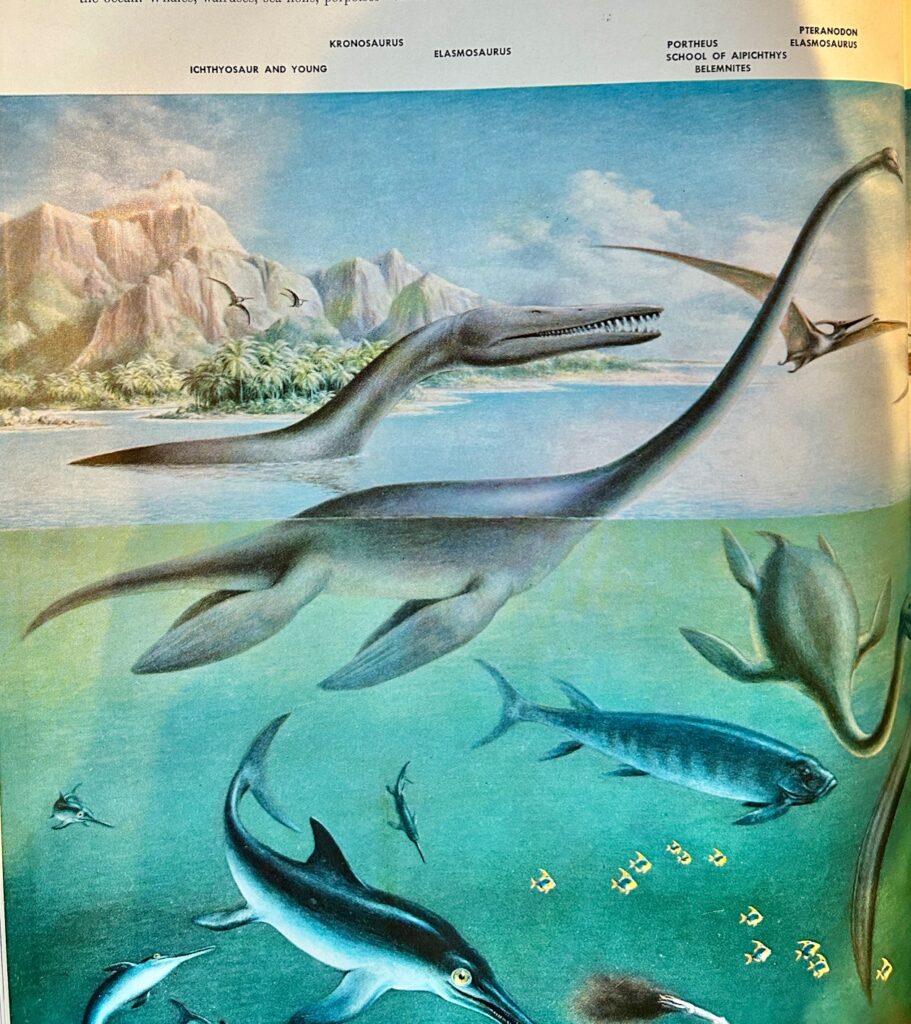
As detailed in my other post on the pot-bellied T. rex, in 1955 the largest toy company in the world, Louis Marx and Company, was facing a dilemma. So vast was their output of playthings that they were running out of ideas. The founder, Louis Marx, was described as “an experienced businessman with the mind of a child.” His idea that toys should be cheap and rapidly produced while still high quality was markedly different from traditional toy-making philosophy. Most toys before Marx came from Germany and were hand-carved from wood. Marx instituted the assembly line approach popularized by Henry Ford for car production and leaned heavily into the profusion of plastics available to civilian America after the war. Louis Marx and Company grew to be bigger than Mattel and Hasbro of today combined, and Louis was dubbed “The Toy King of the World” by a London newspaper.
At his factory in Glen Dale, West Virginia company sculptor Phil Derham waited eagerly for his next assignment. To keep this talented artist from thinking about looking for work elsewhere Marx’s Chief Designer Frank Rice suggested a line of dinosaurs. Popular culture was seeing an uptick in interest in dinosaurs in the mid-1950s thanks to Zallinger’s paintings. These were used as reference for almost all the Marx dinosaurs due to the proliferation of Life Magazines, which had also been serialized in a hefty coffee table hardback in 1955. The dinosaurs marched off Zallinger’s famous mural and into three-dimensional form, while the Kronosaurus was expertly reproduced from “The Reptiles Return to the Sea”.
The Kronosaurus formed one leg of the Large Mold Group trio, the other two being the aforementioned T. rex and a Brontosaurus. The Marx dinosaurs debuted at the 1956 Toy Fair and first appeared in stores in 1957. 14 “dinosaurs” comprised the line, with later sets including yet more species. The Large Mold contingent was produced in seafoam green, gray, and very rarely in light “chocolate milk” brown. They also appeared bedecked in shimmering silver and metallic green colors, but these were only ever issued in playsets. The other colors were occasionally offered in store bins, in keeping with Marx’s philosophy of offering great toys for affordable prices (these bin dinos sold for just a few pennies in the 1950s). The first version of Rex was replaced after the first year with a slimmer version, Kronosaurus was part of the gang until 1961, and the sleek Rex and Brontosaurus persisted until Marx put out its last dinosaur set in 1979. The following year the last of Marx’s U.S. operations ceased when the West Virginia plant closed down, and the company effectively went extinct. Louis Marx himself went the way of the dinosaur in 1982, having sold his company a decade earlier for a cool $54 million (worth over $400 million today). The Kronosaurus lived on though, its molds having been bought by other companies. Unlike the Marx originals, these newcomers were produced in a vibrant rainbow of colors.
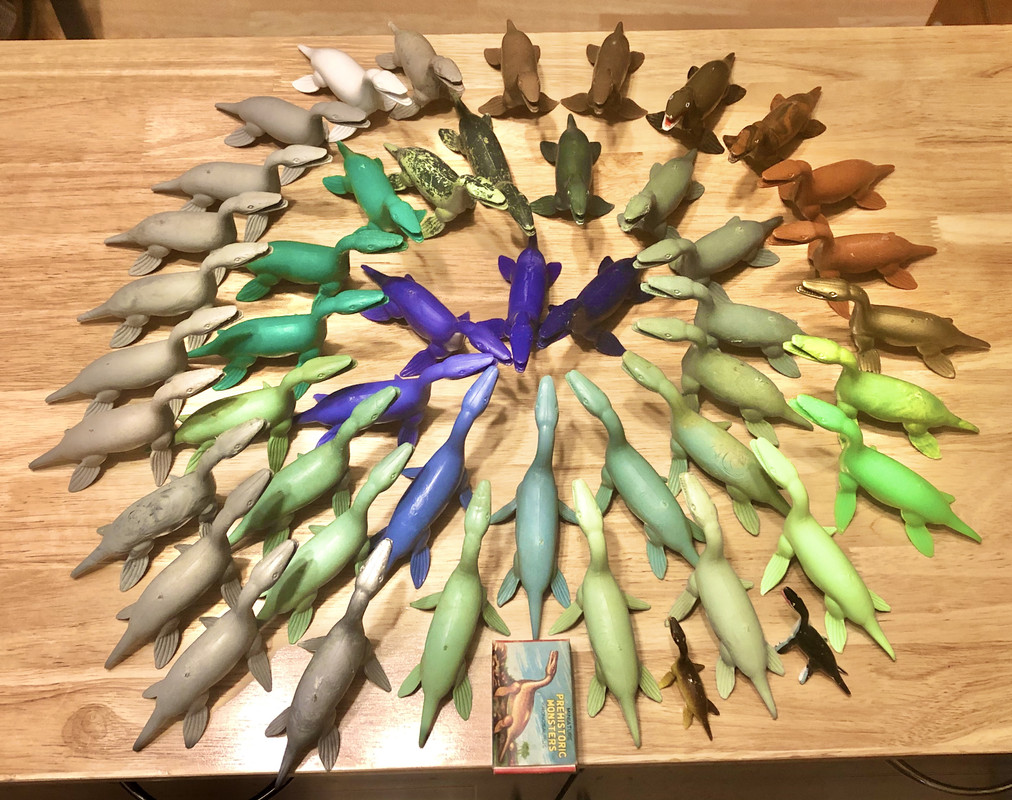
One of the earlier experiments in color was actually true Marx: the 1963 Nuremburg Toy Fair releases. Likely made in the West Virginia factory, these pieces were cast in an altogether different material. Original Marx dinos were made from a leaded plastic whose distinctive smell stirs up nostalgia in old Marx collectors. The Nuremburg set was cast from a much harder and more brittle plastic, hand-painted, and shipped off to Germany for the Fair. The Kronosaurus features a mocha brown body, black flippers, white teeth and eyes with painted pupils, and a red mouth interior. Due to their extremely limited release and charming coloration the Nuremburg set is one of the rarest and most desired variants of the Marx dinos.
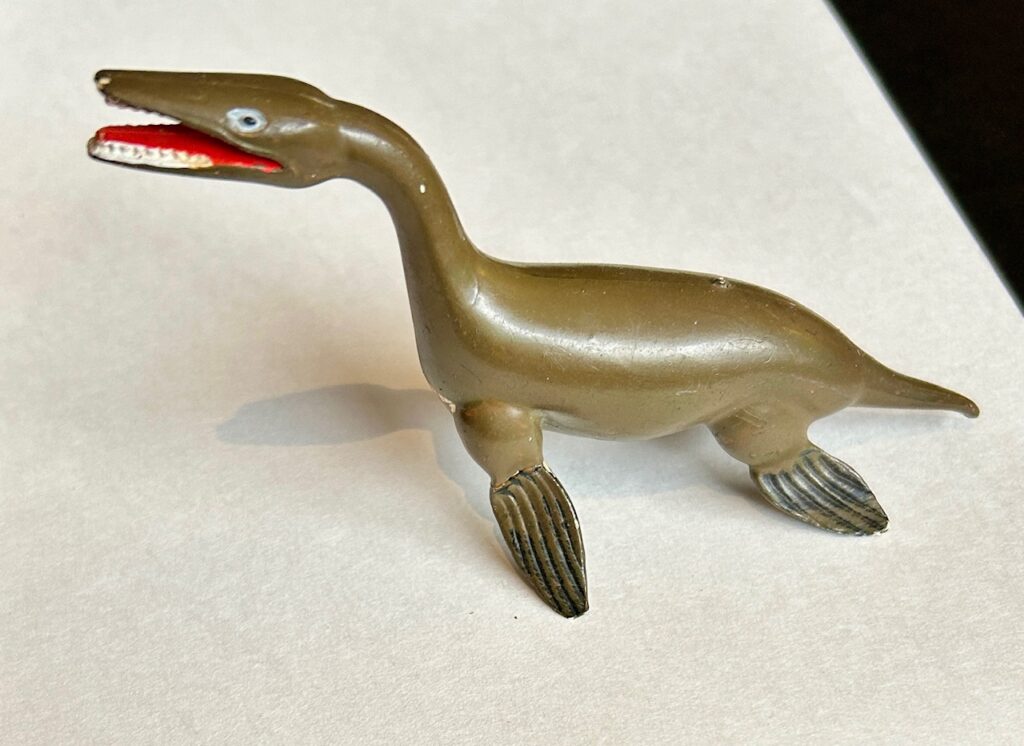
Some other licensed Marx Kronosauruses include the figures put out by Marx’s Japanese branch Line Mar. In the 1950s they produced a line of miniature dinosaurs called Elegant Miniatures featuring a Kronosaurus in a hand-painted pine green color, cast out of cheap pot metal. In the 1960s Line Mar also produced a line of lithographed tin friction wind-up dinos on wheels. This was in the same pine green color scheme.
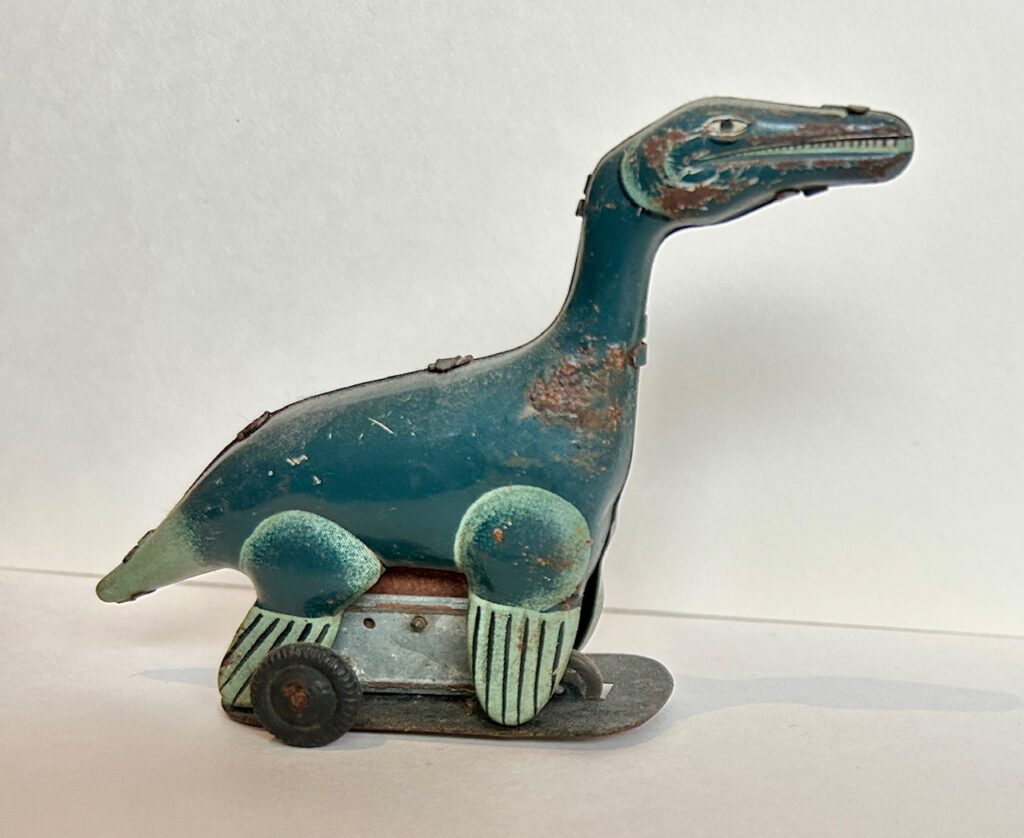
Also in the 1960s Marx’s Hong Kong division Empire Louis Marx (ELM) produced a small plastic Kronosaurus with yellow and brown coloration.
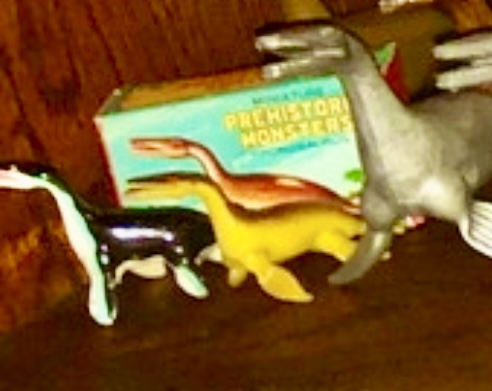
All of these Marx offerings closely resembled the constituents of the original dinosaur set.
The first reemergence of the Kronosaurus in the post-Marx world was when it was produced by the Superior Toy Company of Chicago, Illinois for three years, in 1986-1988. Superior’s dinosaurs were produced in three color schemes, all of which featured two colors swirled together: a brilliant chartreuse green with regular green, gray with black, and brown with black. The next caretaker of the Krono was Toystreet of Caldwell, New Jersey in the late 80s and early 90s. Louis Marx had always had a preference for presenting the dinosaurs in natural, earthy tones, but when Toystreet got their hands on the molds that philosophy went out the window. The Toystreet dinos were made from a cheaper, slightly harder plastic than the leaded plastic of Marx originals and were produced in a bright panoply of colors: purple, green, and orange-brown.
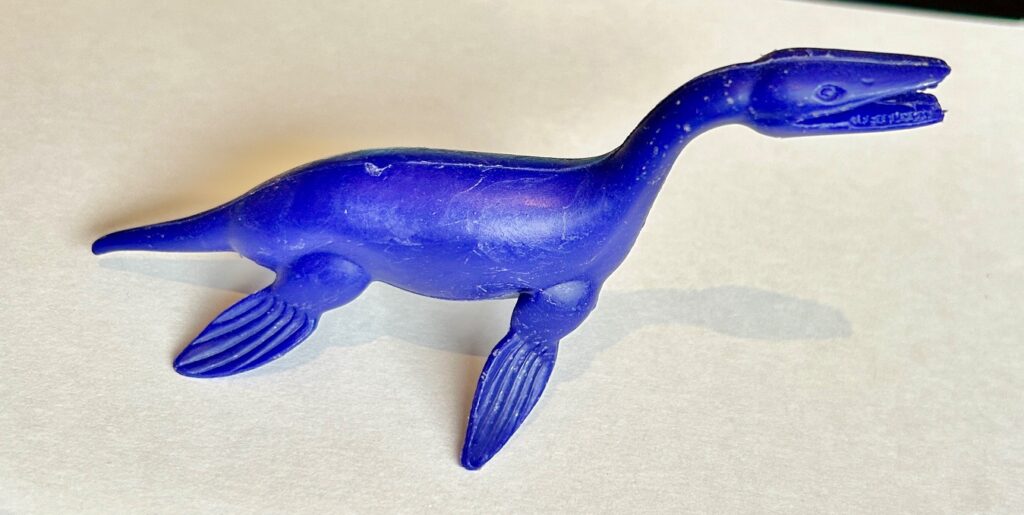
In the mid-1990s the Marx molds crossed the pond and went to Dapol Ltd. out of Chirk, Wales. These included the large mold group and came in two colors: a coffee brown and black. Next came ReMarx of Miami, Florida. These also featured a coffee brown color as well as an attractive cobalt blue. ReMarx were only produced for one year, in 1996. After the turn of the century the molds passed to Marx of Mexico, where they were produced in similar colors to Toystreet.
The Marx Kronosaurus features skin smooth as a dolphin, quite appropriate for a sea-dwelling creature. Its head is elongated and the neck arcs up in an almost perfect likeness of the Zallinger painting.
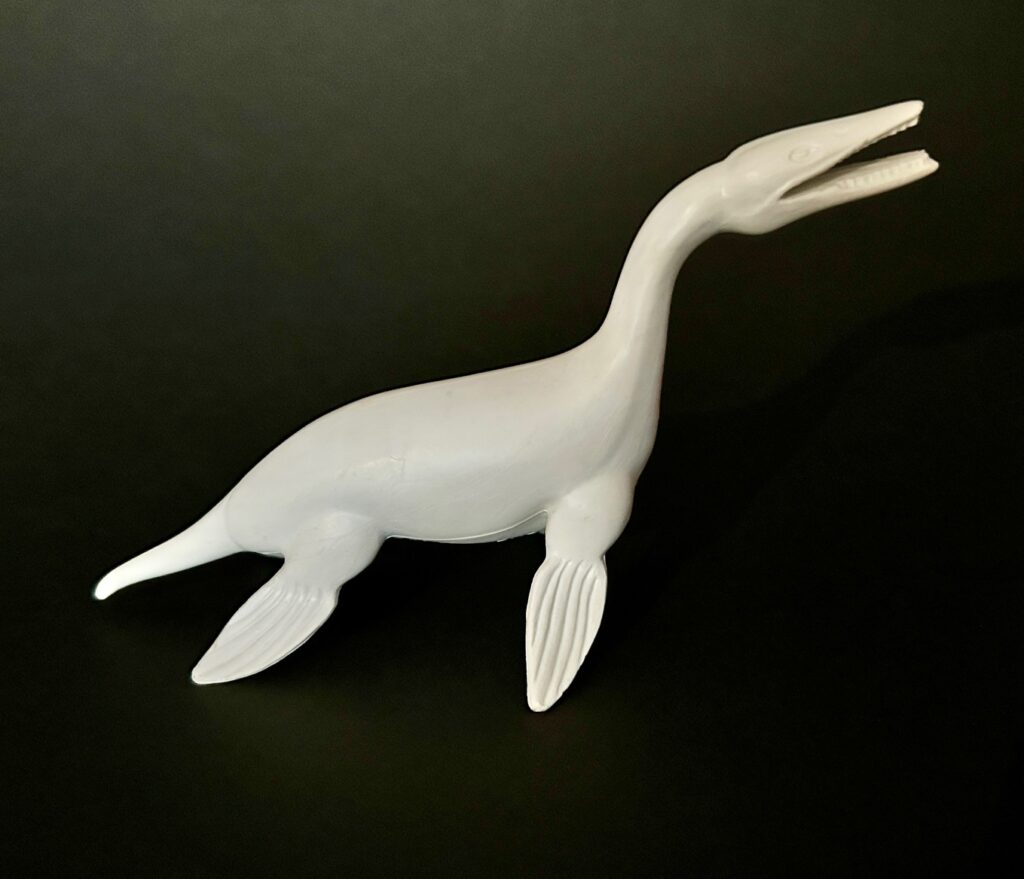
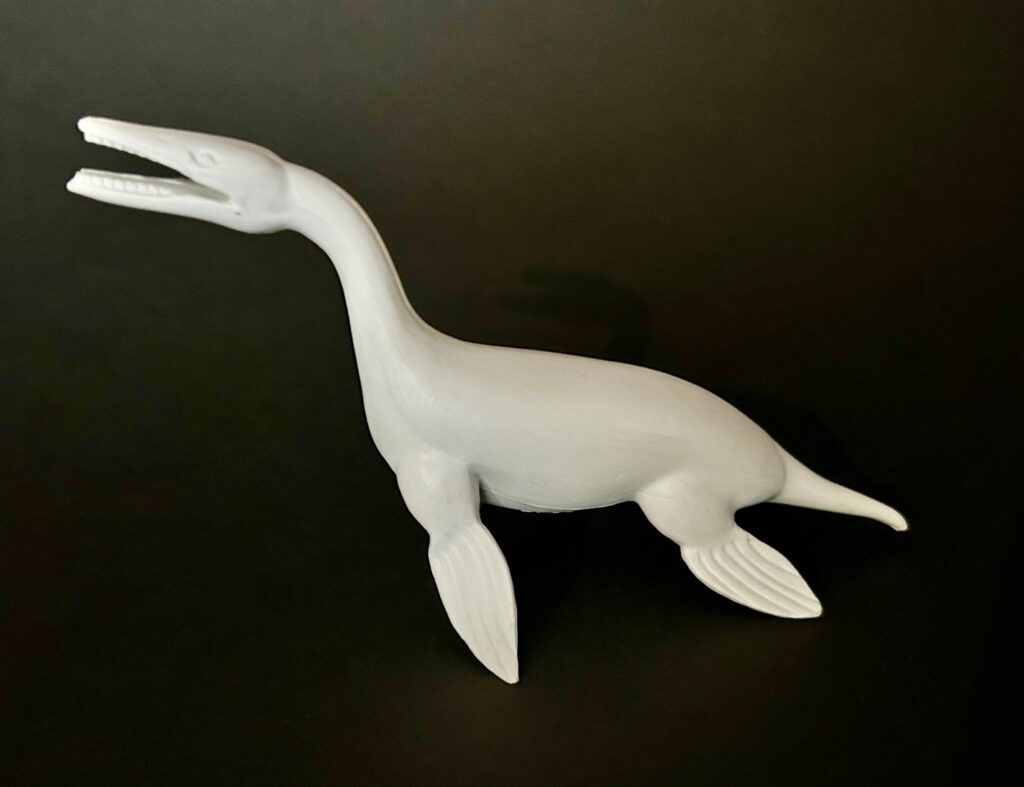
The teeth are visible in the mouth – 20 in the upper jaw and 18 on the lower.
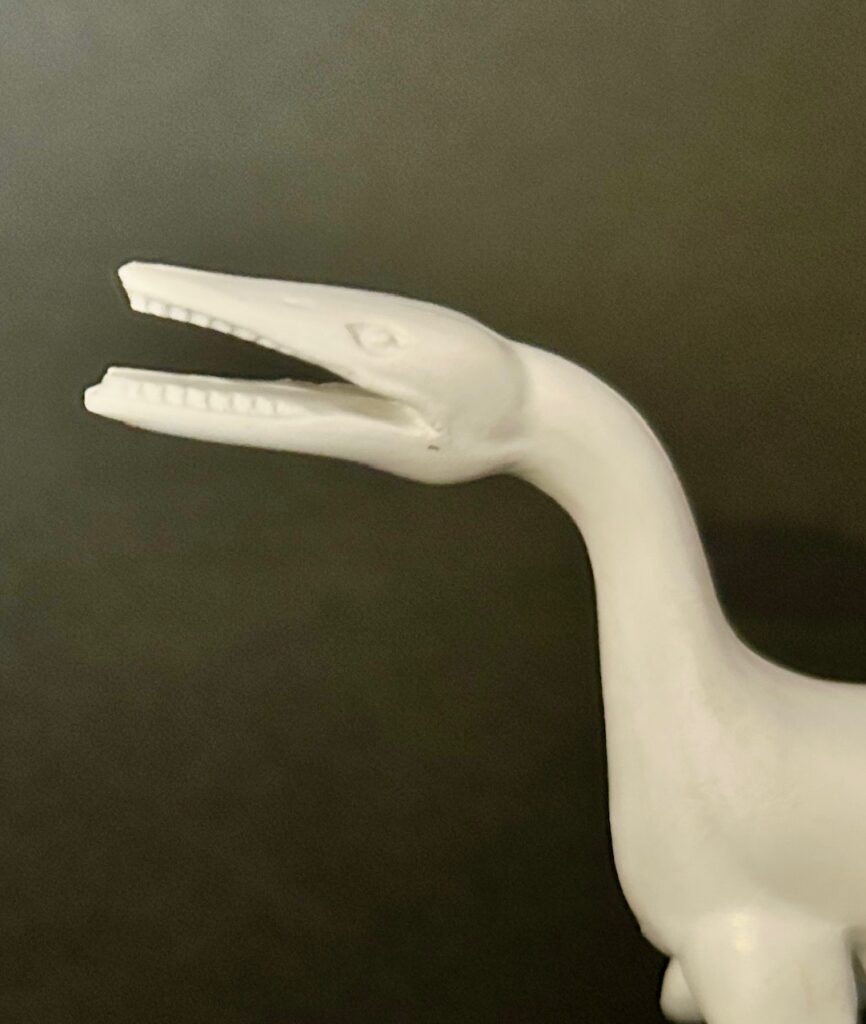
The kidney-bean shaped nostrils are visible on the top of the head just forward of the eyes.
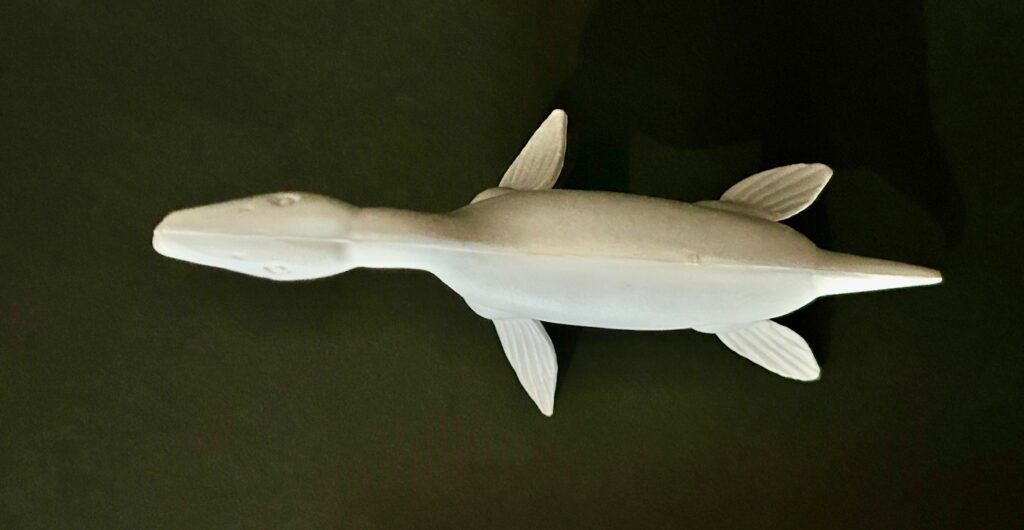
From there sculptor Phil Derham was left to his imagination, and he crafted quite an elegant sea monster. The four flippers are roughly the same size, with the fronts being slightly more elongated.

The base of each limb features a curious mound of tissue. The flippers sport fanciful striations possibly representing indentations for the digits, six on each limb. Kronosaurus actually had five digits in each flipper, but it’s unlikely Zallinger would have known this when he painted his rendition several years before the full Harvard skeleton made its debut.
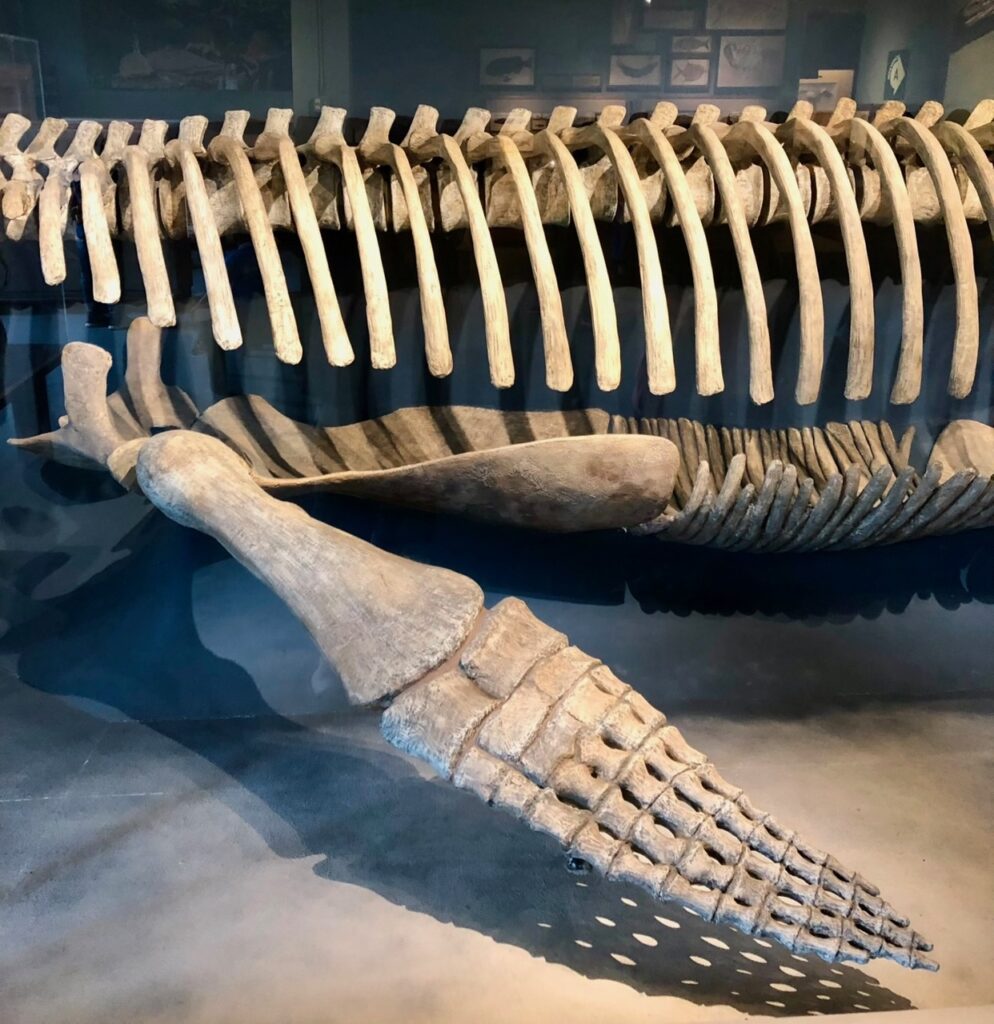
Interestingly, these striations and the general shape of the flippers closely match with the Elasmosaurus pictured next to the Kronosaurus in “The Reptiles Return to the Sea”. Without a depicted body to go off of, it seems probable that Derham combined the two sea reptiles when he sculpted his Kronosaurus in 1955. The figure’s body tapers to a medium-length tail which takes a downward dip at the terminus, also perfectly matching the Elasmosaurus.
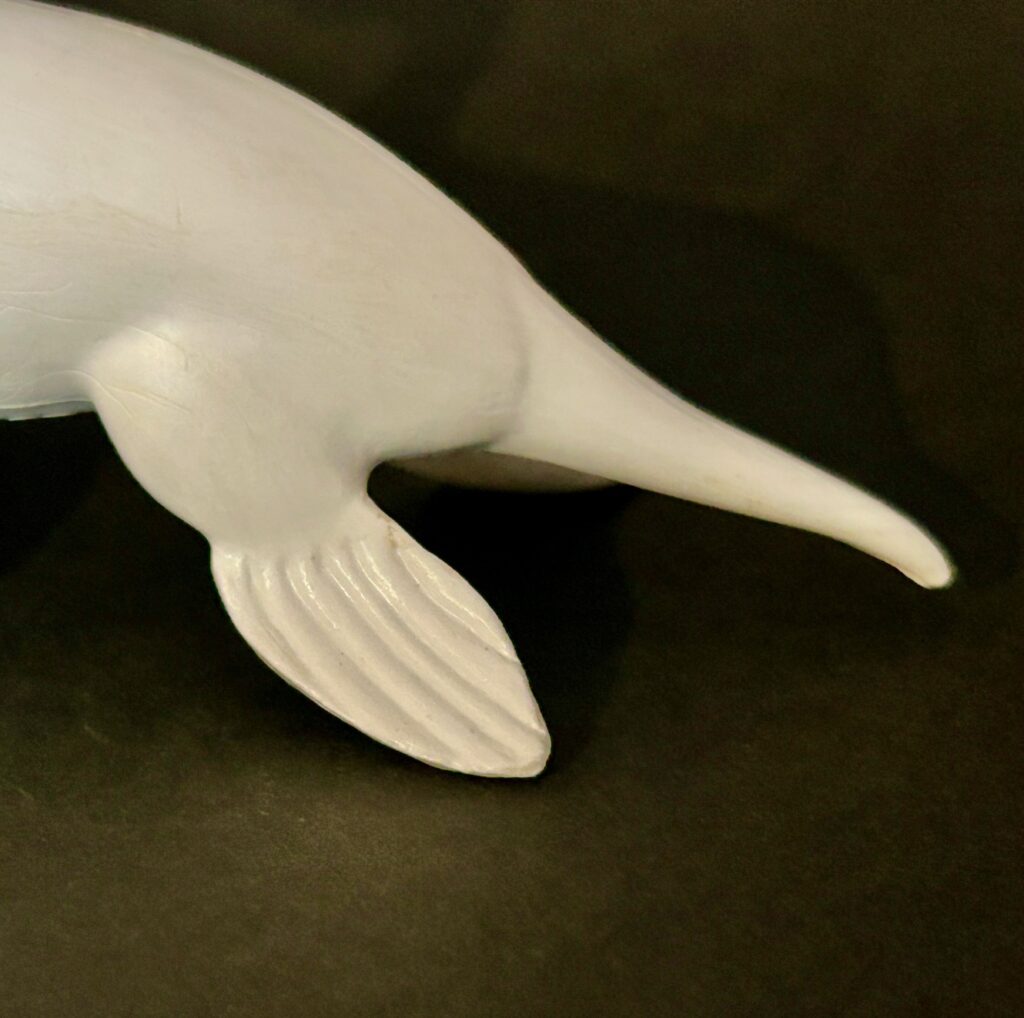
On the underside is written in raised letters: “KRONOSAURUS 50’ LONG”.
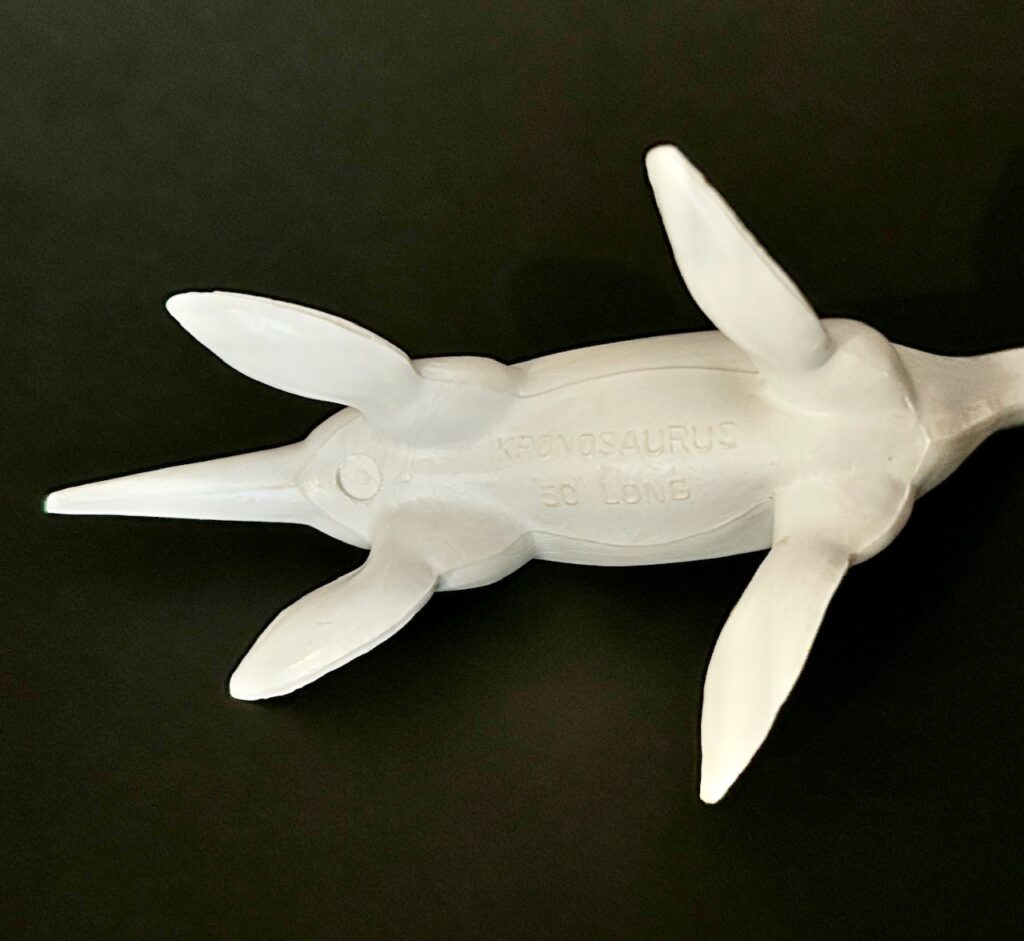
The question of scale is slightly complex. 50 ft. is almost certainly an overestimate. The Harvard Kronosaurus was reconstructed at a length of 43 ft., but because of its incompleteness many of its bones were reconstructed out of plaster, giving the specimen its local nickname “Plasterosaurus”. When Alfred Romer reconstructed it he actually encased the real bone in this plaster and added as many wholly plaster bones as he saw fit. Pliosaur expert Colin McHenry opines that Romer added about eight vertebrae too many.
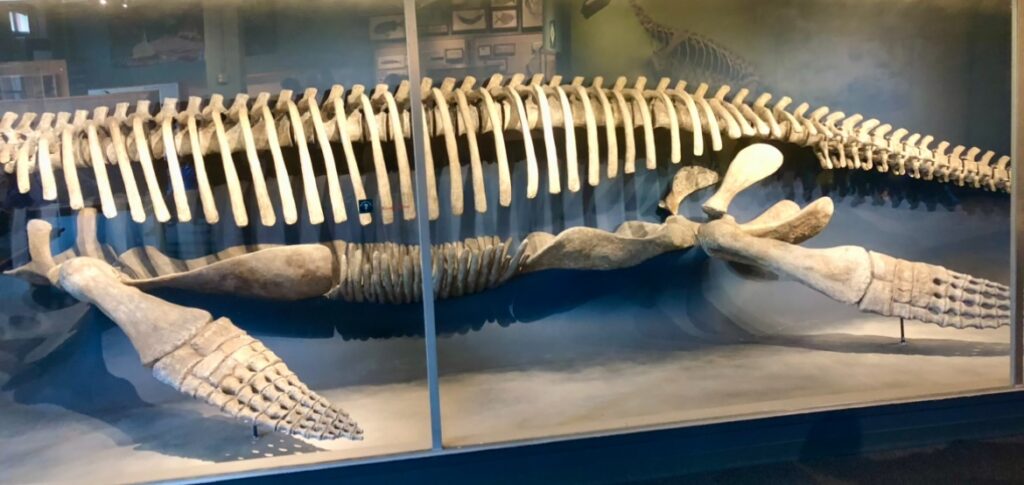
21st century estimates put the length of an adult Kronosaurus at 30-33 ft. (9-10 m). The Marx is 5 inches long (12 cm) and 3.25 inches (8.5 cm) tall, giving the Marx Kronosaurus a scale of 1:106-1:118. [For the purpose of categorizing it on the blog lets call it 1:110 – Ed.]
In talking about the Marx Kronosaurus one should also be aware of its imitators. Call them knock-offs if you will, but hot on Marx’s heels came Multiple Products Corporation (MPC) out of New York. In 1961 they released a line of dinosaurs that bore a striking resemblance to Marx’s in form and pose. Their first offering of 12 dinos included a Kronosaurus.
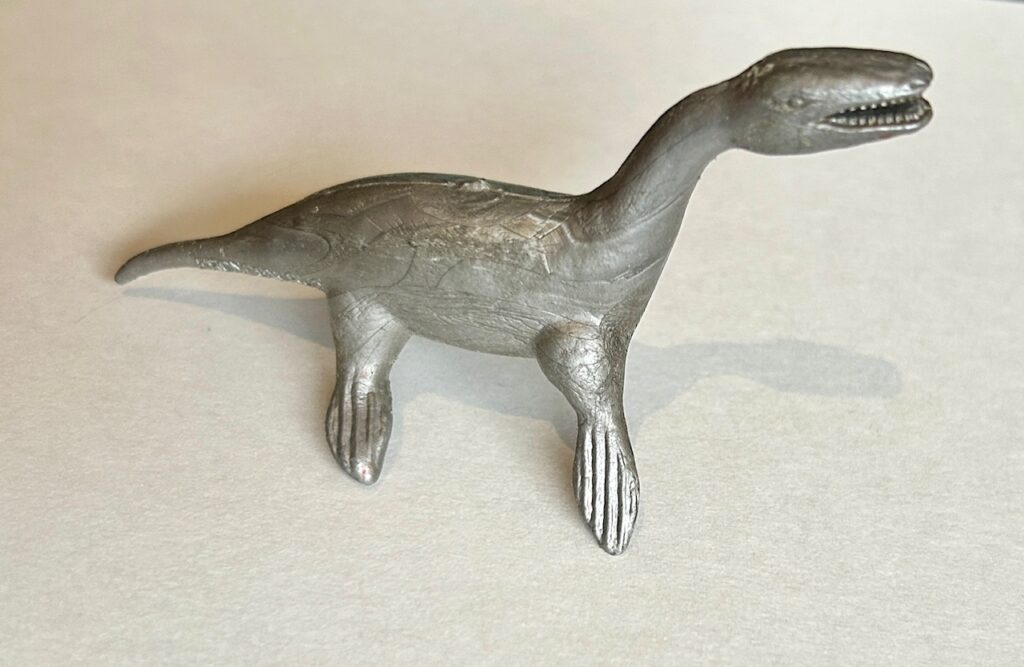
The head isn’t nearly as elongated as its Marx counterpart’s and it is smaller overall, about 3.5 inches (9 cm) long. The MPC Krono features limbs that are off kilter from each other, its right side flippers pulled forward of its left side counterparts, whereas the Marx’s flippers mirror each other in its stoic pose.
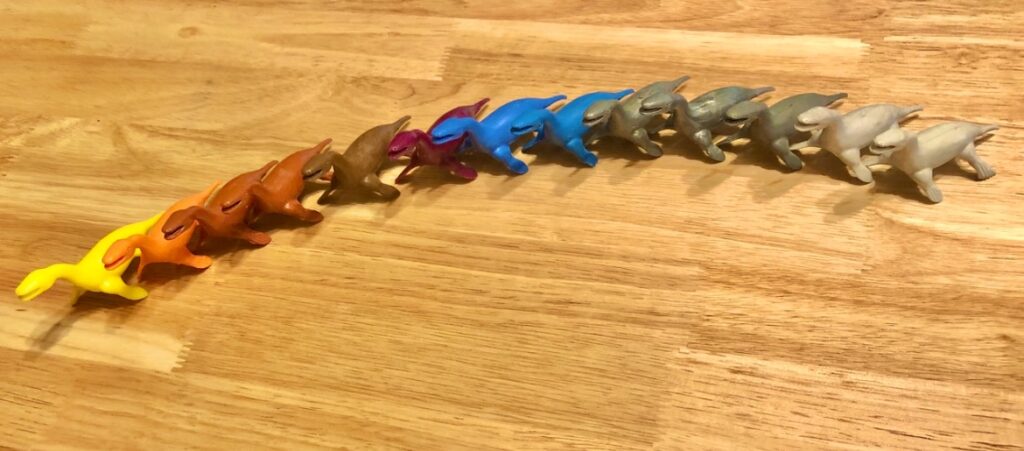
Another toy company trying to get in on the dinosaur game was Winneco Industries, also out of New York. In 1971 they came out with 12 dinos again featuring a Kronosaurus.
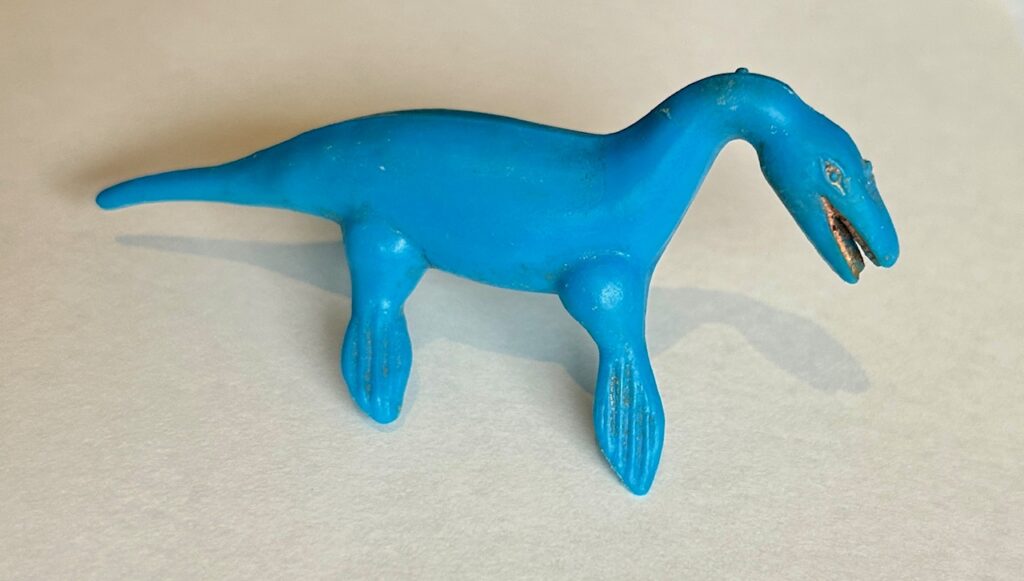
The Winneco is very similar in size and appearance to the MPC but has a distinctive downturned head, whereas the Marx and MPC have an upward gaze.
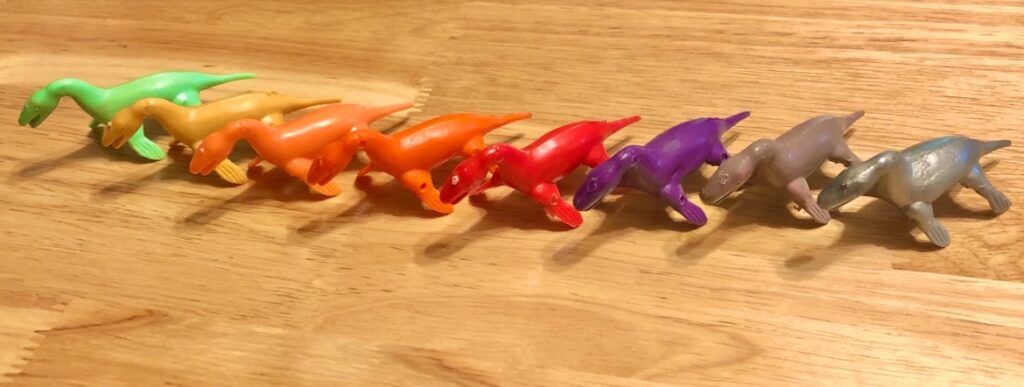


Another thing that distinguishes Marx from its competitors is the strict attention to detail that was a requirement at all Marx facilities. Marx molds were top of the line, with very exacting tolerance. Marx toys have very little excess plastic (known as flash) along the seam lines, have sharp details, and strong consistency of color and shape. To learn more about what happened to the toys that didn’t make the cut check out the link at the end of this review.
One final piece of the Marx Kronosaurus story I’ll share with you involves a trip I took out to Massachusetts and Connecticut in 2019 to see with my own eyes the Harvard Kronosaurus and Zallinger’s painting that inspired the Marx version. I took many pictures of “Plasterosaurus” and bought a shirt at the gift shop featuring the iconic skeleton. At the Yale Peabody I was eager to see the painting “The Reptiles Return to the Sea”. The famous mural was impressive, but I was even more excited when I located the marine reptile painting.
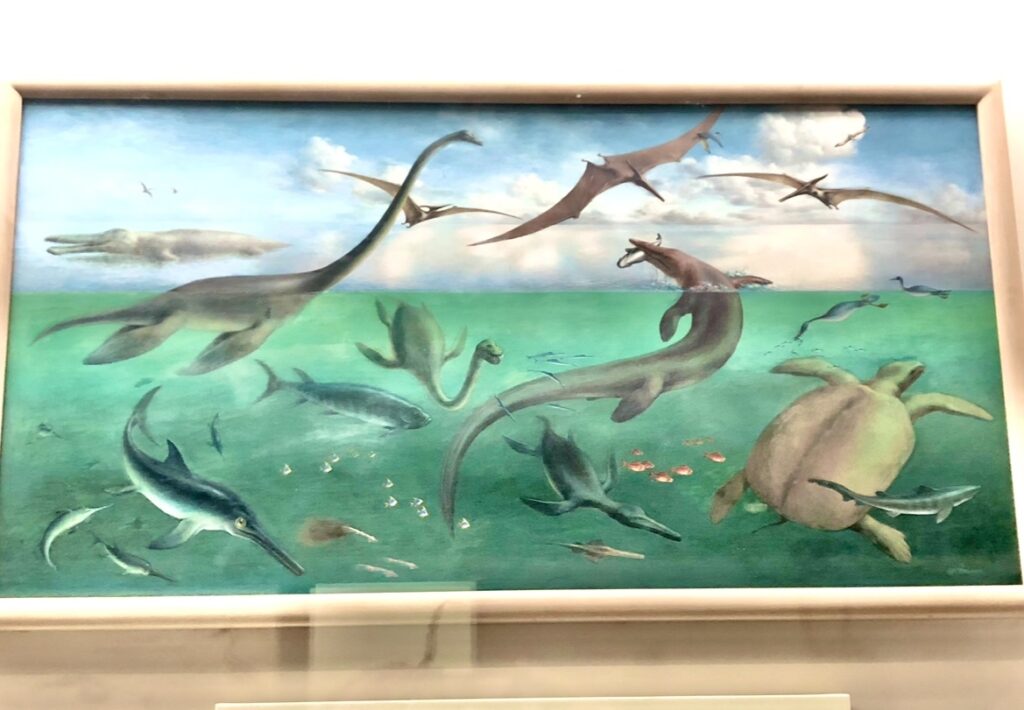
However, my excitement quickly turned to confusion. In the spot where the Marx-style Kronosaurus should have been was a modern, neckless little Kronosaurus.
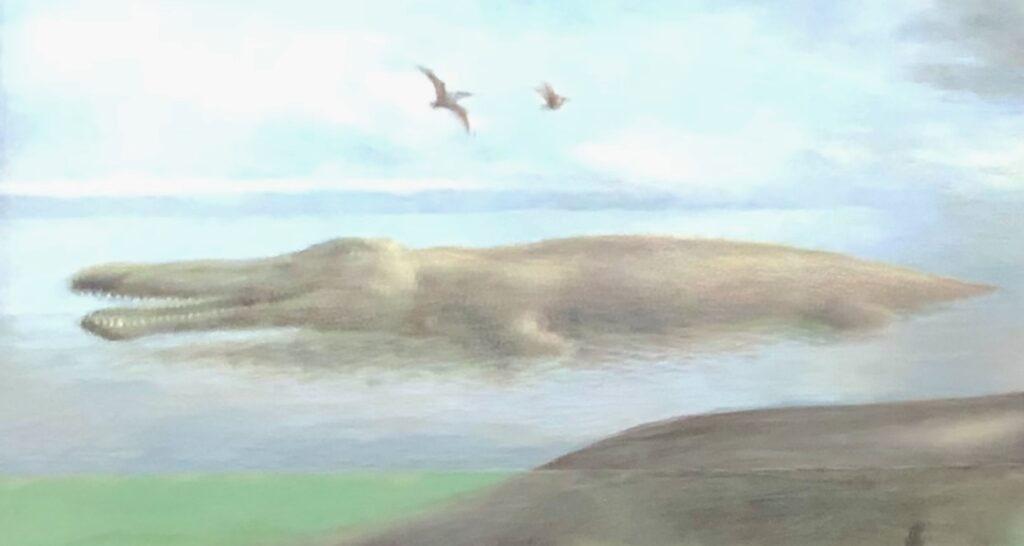
Was I looking at the right painting? All other details were the same, but the Krono was definitely different. I snapped some pictures and went on my way, but I couldn’t stop thinking about the mystery of the Zallinger Kronosaurus. Some time later I called the museum to see if I could find some answers. I was put in contact with Museum Instructor Armand Morgan. He had been working at the museum for many years and had known Rudolph Zallinger before he passed away in 1995. He had the most interesting story to share…
The painting in question had resided in the museum for many years when all of a sudden it disappeared. Several museum staff noticed it was missing, but each assumed someone else had taken it down to do some restoration work. When everyone finally conferred they determined that the painting was not in the possession of any employee of the museum, a jarring realization. Confusion ran rampant, but what could they do? Then one day several weeks later the painting suddenly reappeared in its place! The swan-necked Kronosaurus had been painted over, redone with a more accurate representation that closely resembles the rigid pose of the Harvard skeleton.
Armand explained that Zallinger was a perfectionist and did his best to present the most up-to-date depictions of the animals he painted. The embarrassment of the inaccurate long-necked Kronosaurus must have needled him. Zallinger had full security clearance at the museum, and Armand told me he had no doubt that he had snuck in one night, taken the painting home, and redone the Kronosaurus. Now the Marx-style swan-necked Kronosaurus exists only in old Life magazines, the hardback serialization, and a vintage postcard of the painting Armand was kind enough to send me. Since my trip the museum was closed down for several years for renovations and the dinosaur rooms redone. Now the retouched painting is no longer on display and Armand has retired. I feel very grateful I got the chance to uncover the mystery of this painting that is so significant to me as a Marx dinosaur collector.
A note on the white Kronosaurus pictured in this review: This is the Glen Dale, West Virginia factory test shot, the only one known to exist. A test shot is done by a factory to assess the quality of a mold before full-on production begins. The plastic used was hard and brittle, very different from the softer, leaded plastic used afterward. The reason I decided to use this as my example is because it was the first Kronosaurus ever to come out of the mold and hence has the crispest details of any Marx Kronosaurus in existence. The test shots of the Marx dinosaurs were discovered in the attic of a former Marx factory worker by his widow after his passing. They were purchased from her by Francis Turner, the curator of the Marx Toy Museum where they afterward resided. When the museum closed in 2016 many of its relics were deaccessioned and put up for sale, which is how I got my hands on it. I’m lucky I can share it with you all in this review. Thanks for reading!
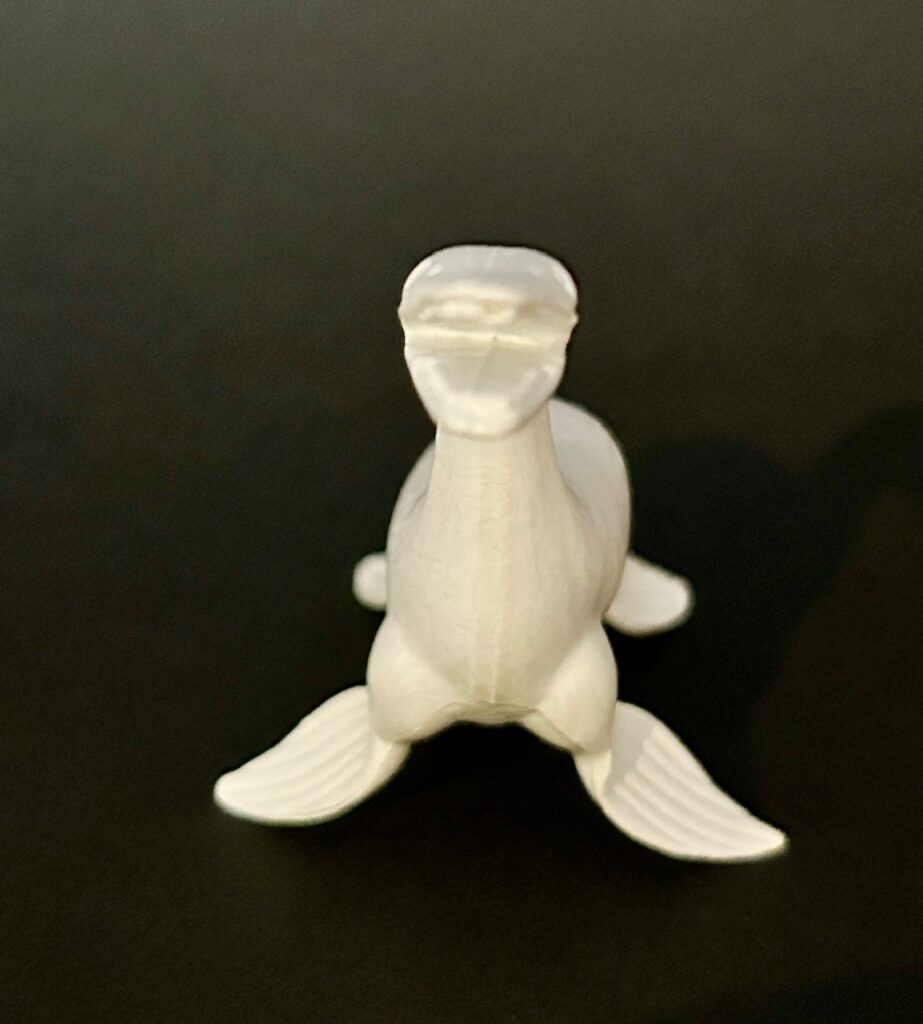
For those still thirsty for more, you can learn about another significant Marx Kronosaurus in my life by clicking here.
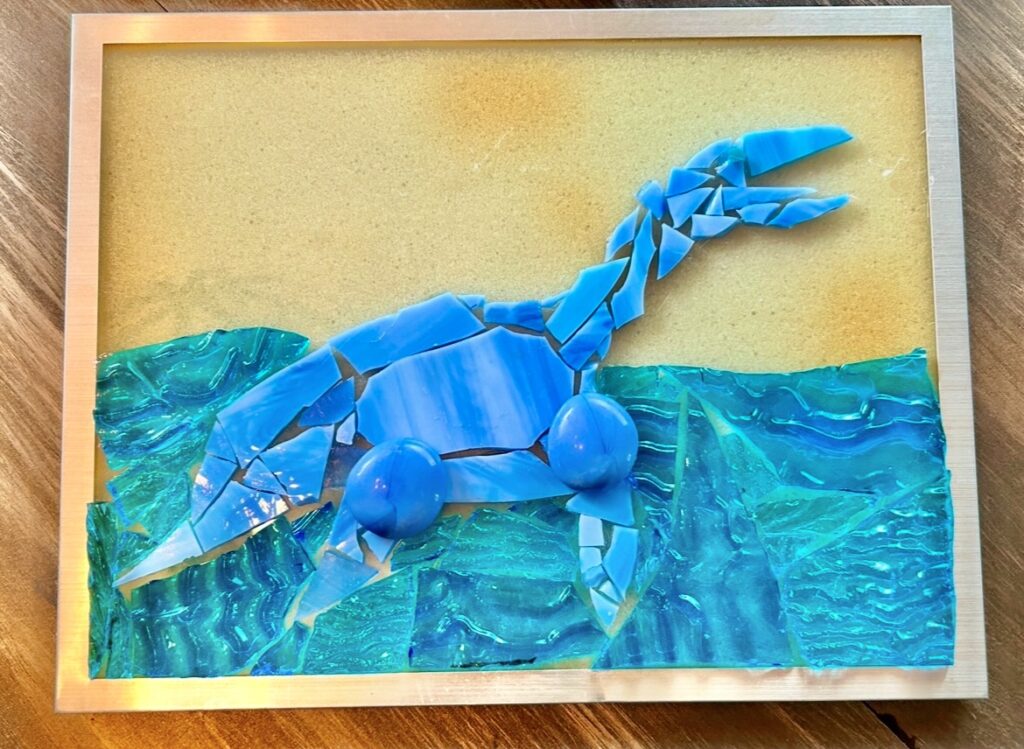
Disclaimer: links to Ebay and Amazon on the DinoToyBlog are affiliate links, so we make a small commission if you use them. Thanks for supporting us!




Great review Bluekrono – what a passion you have for the Marx figures. Wonderful story about Zallinger too!
An exceedingly high-quality review!
I had a wonderful time reading this review. I think the toy itself is pretty ugly, but has a weird charm to it. 3 stars!
This is a magnificent stroll through history! My own history with Marx toys has largely been a recent development, but I’ve certainly admired the otherworldly elegance of early paleoart that the Kronosaurus captures. Thank you for such a thorough review of this iconic figurine!
I have the intrepid editor to thank for that!
Astonishing story about Zallinger sneaking in, stealing his own painting, and returning it edited! 😮
Nice to see more detailed reviews of classic figures (perhaps the most detailed one yet)! And didn’t know one could make image captions, never seen that before here.
This is a really great review that reveals more detail into the history of Marx prehistoric reptiles. Sounds like something one would find in a book about the subject. I’ll give it a five.
And forgot to mention, by some accounts, this figure actually depicts the new genus “Eiectus”…